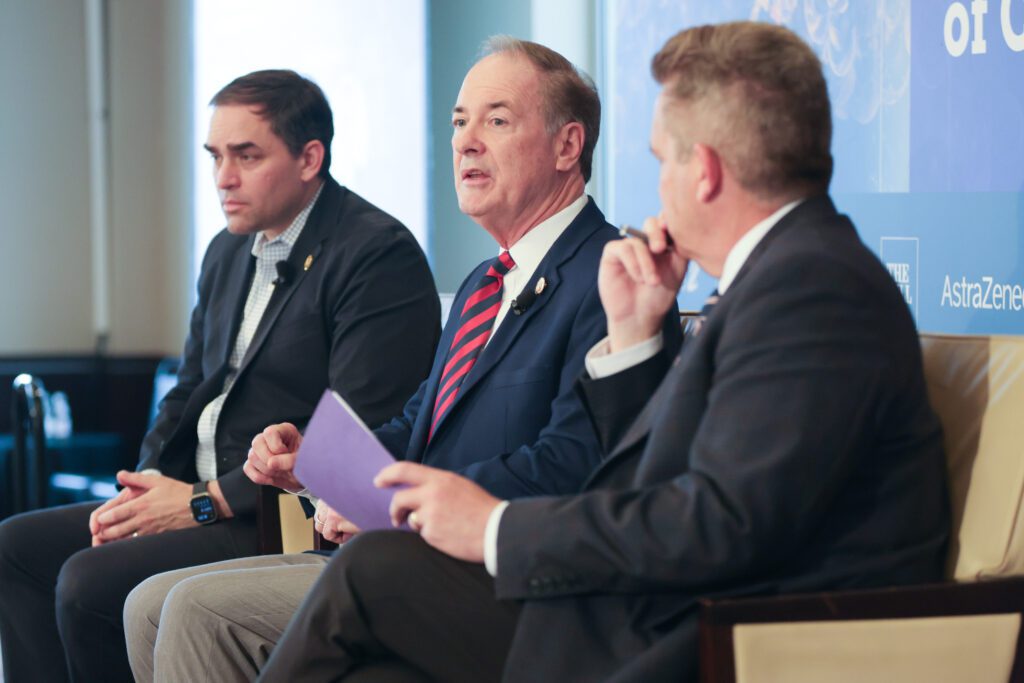By 2050, the number of people worldwide with cancer could increase 77%, according to a report published by the American Cancer Society in April 2024. In fact, 1 in 5 people alive today will develop cancer in their lifetimes, with as many as 35 million cases expected to be diagnosed in 2050.
And while cancer mortality has continued to decline, due in part to earlier detection and improved treatments, the rise in cases—alongside higher mortality rates in low-income countries—highlights the importance of both continued innovation as well as ensuring access to that innovation.
This topic—and specifically, the role of policy in supporting innovation and access—was central to the discussion during a May 9 panel hosted by The Hill, The Future of Cancer Care. Sponsored by AstraZeneca and featuring policymakers, patient advocates, and Biotechnology Innovation Organization (BIO) President & CEO John F. Crowley, the event highlighted significant advances in cancer research and care, and specific policy proposals that could ensure access to innovation.
From a ‘death sentence’ to a cure
“Five years ago, metastatic melanoma was often a death sentence,” said Rep. John Joyce, M.D. (R-PA), a dermatologist. “Now, diseases like metastatic melanoma are curable with the treatments that have developed since I came to Congress—not because of what I did in Congress, but because of the innovation and research that industry continues to do.”
Funding the Cancer Moonshot is a priority, said Rep. Wiley Nickel (R-NC), who lost his father to cancer: “We have the resources to do it. We need to make those investments.”
Increasingly, many of these breakthrough immunotherapies are being found to successfully treat other kinds of cancers and diseases—like the immunotherapy that cured President Jimmy Carter’s metastatic melanoma of the brain, which has been found to be successful against squamous cell carcinoma of the lung. But under the Inflation Reduction Act (IRA), orphan drugs for rare diseases—including many cancer drugs—are exempt from price controls only if they’re approved for just one rare disease.
The ORPHAN Cures Act would remove those drugs “from the Medicare price negotiations so that we can continue to see that innovation extend into other arenas,” continued Rep. Joyce. “We want to see that innovation. We want to see that investment occur in research and development. And the only way that we can see that being successful is with a minor modification, a minor tweak, if you will, to the IRA.”
How policy can support – or hinder – the future of cancer care
During a fireside chat with BIO President & CEO John F. Crowley, the ORPHAN Cures Act came up in the context of access.
“Somebody once told me there’s nothing in the laws of nature that says that we can’t cure every cancer—only the laws of man,” he said.
We’ve made great strides in innovation, but “innovation without universal access is insufficient. So, let’s identify and break down barriers to access.”
This includes policy barriers, like provisions of the IRA that would hinder innovation. As Rep. Joyce noted, the ORPHAN Cures Act would fix the IRA “so that we make sure that we don’t prejudice research, we don’t prejudice capital flowing into the rarest of cancers, and we don’t put up any artificial barriers to let science tell us where to go.”
We also need to fix the IRA’s so-called “pill penalty,” which creates an “artificial distinction between nine versus 13 years. So, if you have a large molecule, a biologic, you get 13 years of protection before you’re subject to the IRA pricing mechanisms. If it’s a small molecule, you get nine years of protection,” explained Crowley. “What that does is penalize the development of small molecules.”
“And that’s a shame in cancer, especially where we need small molecules,” he continued. “Oftentimes, it’s the small molecules that can cross the blood-brain barrier. They are also the medicines most likely to become generic and, in the end, push down the cost of medicines in the healthcare system.”
The Ensuring Pathways to Innovative Cures (EPIC) Act would fix this by bringing the small molecule exemption to 13 years, he noted.
In addition to incentivizing investment in cancer cures, Crowley discussed the importance of addressing out-of-pocket expenses for oncology treatment.
“Who in the world is ever going to take an oncology medicine because there’s no out-of-pocket cost? Well, hey, it’s free. I think I’ll try this. No, not at all. It doesn’t work [like that]. Let’s find a way to do away with out-of-pocket expenses in oncology,” he said. “And we have to look at the whole system for how we’re going to pay for that.”
What’s next for oncology innovation
“In the last 10 years in oncology, we’ve had 133 new medicines approved 14 last year,” continued Crowley, citing cancer innovations from CAR T to gene therapy, vaccines, and mRNA. “That’s good, but it’s not enough.”
Watch what he said about innovation and the future of cancer care:
Additional speakers at the event included Dr. Danielle Carnival, Deputy Assistant to the President for the White House Cancer Moonshot, and Mohit Manrao, SVP & Head of the U.S. Oncology Business Unit at AstraZeneca. Patient advocates from the National Comprehensive Cancer Network (NCCN), American Cancer Society Cancer Action Network, and Tigerlily Foundation also shared their experience and the importance of advocacy to seeing the future of cancer care move forward.
You can watch the whole event here:




